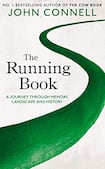
As befits a book about running, John Connell’s latest volume weighs in at a trim 165 pages, with no visible flab. Most of the runs described in it are long-distance, but the chapters are short too. The author’s speciality is the vignette. His book unfolds like a series of 400-metre loops, circling around again and again to the same place, although Connell’s philosophical reflections ripple ever wider in the process.
Despite the title, this is not any kind of coaching manual. The Running Book builds on the franchise of the author’s farming-inspired 2018 hit, The Cow Book, and is similarly structured, with the mixture of memoir and travelogue in this case punctuated by his feats of athletic endurance and the insights they offer.
There is poetic logic to the progression. As Connell points out, the word for “road” in Irish, bóthar, means “the cow way”: a relic from an era in which traffic was mostly four-legged. It seems a quaint idea these days, when even the most remote rural road is the car way and pedestrians, bovine or human, are all but extinct.
Indeed, Connell describes nearly becoming extinct himself one night when he ran out of daylight and had forgotten his “hi-vis”: the uniform now compulsory on Irish country roads, where walking, running, or cycling qualifies as extreme sport. Happily, somehow, the author managed to cover large swaths of his native Longford on foot and live to tell the story.
Longford is a big part of that story. Despite being well off the tourism trail – before Center Parcs anyway – the county has been central to some of the most formative events in Irish history, from the 1798 rebellion, through the War of Independence, to one of the darkest days of the 1980s.
While passing through Ballinamuck or Ballinalee, or the tragically resonant Granard, a thoughtful writer like Connell has plenty of material to distract both himself and readers from the hardship of the tarmac. Maria Edgeworth and Jane Austen also feature as background characters, the latter via a local Mr Darcy, from whom she may have done well to escape.
If Longford is the book’s inner circuit, there is an outer one too that ranges from memories of Dublin and London to Los Angeles and the Navaho Country of Arizona. Running themes – apart from running – include the struggle of indigenous peoples to emerge from colonialism, something that unites Ireland’s north-midlanders with native Americans.
En route, Connell pays homage to sporting heroes, including the barefoot Olympian Abebe Bikila and multiple marathon winner Paula Radcliffe, and also literary ones. Among the latter is Henry David Thoreau, whose retreat to Walden Pond helped inspire Connell’s own reinvention as a writing farmer.
But like many deep thinkers in history, Thoreau preferred long walks as a form of mind-clearing exercise. And in general, running has traditionally been scorned in literary circles, as something inimical to creativity. So a more obvious debt for Connell, duly acknowledged, is to the veteran Japanese novelist Haruki Murakami, who beat a path for him in more ways than one.
Murakami has married a life-long marathon habit with being a giant of literary fiction. He took time out from novels a few years ago to write a similarly well-toned volume about his athletic feats: What I Talk About When I Talk About Running.
Anyone expecting deep eastern wisdom in that might have been disappointed with the master’s gnomic utterances. But Connell’s north-eastern wisdom is more grounded. Everything comes back to Longford, to the land, and to Ireland’s struggle for self-expression, which informs the author’s own. The male Connells, as he notes, went from being on-the-run to recreational running in the space of two generations.
Although he cannot be neutral about Ireland’s past, the author is always generous. Balance is vital to a runner after all. Wherever possible, Connell avoids taking either side of the road of history, where the camber is unforgiving, in favour of the middle way.
One of the book’s pithier lines divides endurance athletes into two types: those running towards something and those running away. The author appears to be in the latter camp.
He speaks again here about the “lost time”, the suicidal depression that brought him back to the farm, which was also the “time before running”. Taking up the sport was a deliberate strategy, a framework he could rebuild his life around: “I run so that I might never go back there.”
But there are always things to run towards too, even if these are not prizes or personal bests (to both of which Connell is indifferent). The semi-mythical “runner’s high” can be a goal. So can the sheer emptiness of mind a long run sometimes brings. When you can finally stop, even the exhaustion feels like a reward.
In later chapters of The Running Book, Connell finds himself far from where he started: the Mojave Desert. It tempts him towards a big philosophical finish on the penultimate page that, a bit like a sprint at the end of an ultramarathon, doesn’t quite come off. But wisely, he leaves the last words to Longford. There he finishes on familiar ground, his goal achieved: tired but happy, and home.














